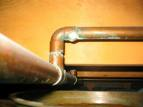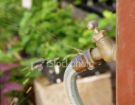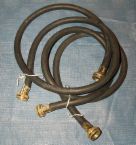If you've ever had a frozen copper pipe, you know the tremendous force that freezing water can exert. As water freezes, it expands, and although copper is very strong, the force of expanding water and ice can split a copper pipe wide open.
force that freezing water can exert. As water freezes, it expands, and although copper is very strong, the force of expanding water and ice can split a copper pipe wide open.
In addition to water spraying out of the opening, you will have to do some quick thinking. First of all, get the water to stop spraying out of the pipe. Here is an article on how to shut off the water. Once you have the water turned off and have cleaned up the water-soaked area, you are going to need to repair the pipe.
Usually, you will see a nice hole in the pipe with the edges of the copper peeled outward from the pressure. Typically, you will have to cut out the damaged section with a pipe cutter (avoid using a hacksaw as it will leave nasty edges). Once you have cut away the damaged section you will be left with a void in the pipe. You will then use a repair coupling to span the void.
A repair coupling has no stops in it and so you can place it over the pipe and slide it to wherever you need it to go (this is also known as a repair sleeve). From there you will need to either sweat the coupling in place or use a copper adhesive, but check to make sure that your local building authorities allow a copper adhesive, as some don't allow it. Here is an article on how to solder copper piping.
 If you've ever had a dripping hose faucet (aka a hose bib) handle , you know how frustrating it can be. You can turn the handle as hard as you can and yet it still won't stop leaking around the handle. This is true for washing machine hose faucets as well. Sure you could replace it, but try a quick repair first.
If you've ever had a dripping hose faucet (aka a hose bib) handle , you know how frustrating it can be. You can turn the handle as hard as you can and yet it still won't stop leaking around the handle. This is true for washing machine hose faucets as well. Sure you could replace it, but try a quick repair first.
The handle is attached to the faucet via a cap. This cap screws onto the hose faucet. The first thing I would try is to tighten this cap by a quarter-turn. This may stop the leak, but you may notice that it is harder to turn the faucet on-and-off. Personally, I can live with that.
Underneath this cap is the secret to no leaks: packing. Packing looks like a small rope made of Teflon, and it comes in a variety of diameters. You wrap this packing around the stem and as you tighten the cap back down everything compresses to seal out any leaks. If you add packing and it still leaks you can add a little more.
Had the faucet leaked at the spout (where water is supposed to run out), you could have tried to disassemble the faucet and replace a washer, or just replace the hose faucet.
 A realtor called us today to troubleshoot a plumbing problem. They represented a bank and turned the water on to the house, but water was not flowing into the house. I suspected that the shutoff valve in the garage was not functioning.
A realtor called us today to troubleshoot a plumbing problem. They represented a bank and turned the water on to the house, but water was not flowing into the house. I suspected that the shutoff valve in the garage was not functioning.
It's pretty common when you shut off the water to a house with an old gate valve, the gate that controls the flow of water will drop down and stop the water from flowing into the house. As long as the water is on and the pressure is maintained, the gate will typically stay in place.
To get the water flowing again, you will need to replace the valve, or at least pull the broken gate out of the valve. The quick fix is to pull the broken gate out of the valve. This means that in the future, in order to shut off the water to the house, instead of turning it off at the gate valve, you will need to turn it off at the street. That probably isn't a big deal to most people.
So turn the water off at the street and put a wrench on the top half of the gate valve. The top will come off in one piece. Then reach down into the lower half of the valve and pull the broken gate out. Put everything back together and turn the water back on at the street.
 This picture is from a customer's house. This is a plumbing pipe repair from someone that I'm guessing has never done plumbing before. The reason I say that is because the repair looks like it was done by someone with a knowledge of arts & crafts rather than a knowledge of plumbing.
This picture is from a customer's house. This is a plumbing pipe repair from someone that I'm guessing has never done plumbing before. The reason I say that is because the repair looks like it was done by someone with a knowledge of arts & crafts rather than a knowledge of plumbing.
I can only guess that the pipe was leaking and instead of replacing the section of pipe or replacing a damaged fitting, the homeowner bought some type of a fiberglass repair kit or maybe a paper-mache kit and wrapped wet strips around the damaged pipe...then crossed his fingers. It looks like after the material hardened he turned the water back on and didn't see any geysers. However, it appears the fiberglass/paper-mache repair just diverted the leak where he couldn't see it any longer. The drip or leak at that point turned into a nice rusty section of the piping. There really are so many ways to get information on a repair, even if you don't know anything about it (one is this website), there is no excuse for something like this.
The story ends with the homeowner becoming a casualty of the foreclosure market. Enter the new homeowner who bought the house "as-is" and now has some repairs to take care of.
 We got a call from an existing customer today that she had an emergency with her shower plumbing. We had worked on this very shower 3 weeks ago and it has been working great since. Well today the homeowner couldn't get the cold water to shut off in that shower. She had to shut off the water to the entire house from the street. In came the call.
We got a call from an existing customer today that she had an emergency with her shower plumbing. We had worked on this very shower 3 weeks ago and it has been working great since. Well today the homeowner couldn't get the cold water to shut off in that shower. She had to shut off the water to the entire house from the street. In came the call.
We took apart the shower valve and discovered that some small pebbles had made their way in between the stem and the seat of the valve (these parts mate together to seal off any water from passing through). So with the rocks keeping the valve open the water wouldn't turn off.
Sometimes when the city or water company services the line underground, invariably some debris will get into the line. Whoever turns on the water first will carry the debris wherever the water pressure takes it. In this case, it was to our customer's shower.
We explained this to the customer and she mentioned that the water company had some workers working on the water supply recently. She saw large pieces of construction equipment and piles of dirt but didn't put it together.
Over the weekend I got a call from a customer that had just  arrived home after an extended vacation. She had a great vacation and was looking forward to relaxing after unpacking. Her heart sank as she opened the front door to find 2 inches of water all over the floor.
arrived home after an extended vacation. She had a great vacation and was looking forward to relaxing after unpacking. Her heart sank as she opened the front door to find 2 inches of water all over the floor.
The culprit? The rubber washing machine hoses that we all ignore. One of the hoses at the rear of the washing machine had ruptured and flooded the house. Now she gets to have another extended vacation, this time at a motel, courtesy of her insurance company.
Go now and buy 2 braided stainless steel washing machine hoses. They cost $10.00 each and you will need 2 of them. Turn the water off at the hose faucets, unscrew the old rubber hoses and simply screw on the new hoses. Connect the new ones to the same fittings as the old ones (hot faucet to hot inlet and cold faucet to cold inlet). You can also buy "floodsafe" hoses for toilets and the like that have a pre-set flow rate. If the flow rate of the water exceeds the setting, the water flow will stop to that fixture.
This is one of the easiest plumbing jobs out there, and it could save you thousands of dollars and weeks of inconvenience.